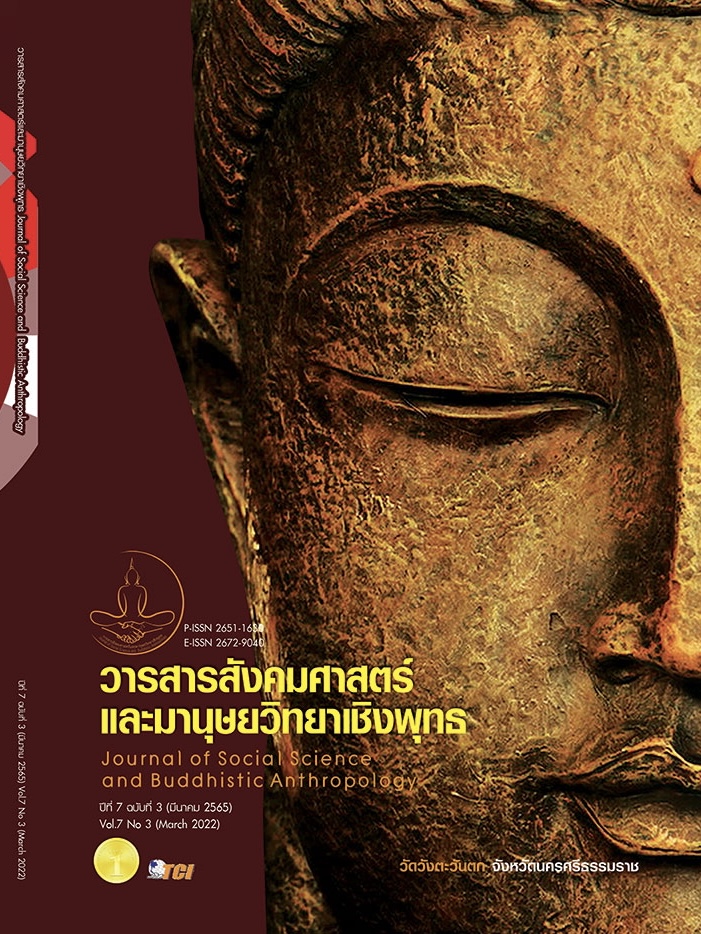MODEL OF BUDDHIST TOURISM MANAGEMENT BASED ON THE CONCEPT OF WAT PA UDOMSOMPORN, SAKON NAKHON
Keywords:
Buddhism Tourism, Sakon Nakhon, Buddhabatvernpla, Wat Pa UdomsompornAbstract
The objectives of this research article were to 1) study the behavior of tourists traveling to Wat Pa Udomsomporn 2) study the tourism management model at Wat Pa Udomsomporn 3) propose a Buddhist tourism management model based on the setting of Wat Pa Udomsomporn. Qualitative data were collected through interviews and non-participant observations. Sampling selection consists of 36 individuals that can be classified into 3 groups: tourists, tourism service providers such as local hotel and restaurant owners, and lastly, representatives from Wat Pa in Sakon Nakhon. The findings demonstrate that tourists visiting Wat Pa Udomsomporn prefer personal vehicles and tour buses as their modes of transportation; they tend to visit the temple on Buddhism commemoration days and Luang Pu Fan Ajaro’s remembrance day, and share similar key characteristics: a strong belief in the three gems of Buddhism, otherwise known as Triratna, and faith in Luang Pu Fan Ajaro. The tourism management at Wat Pa Udomsomporn was noticeably simplistic and straightforward. Visiting the Luang Pu Fan Ajaro’s museum to study his history and monk’s regulations such as simply and detached living is a major attraction. This will be adapted in life to live peacefully and sustainably. Upon careful analysis of data, the authors have proposed the Three Steps of Buddhist Tourism Management Model, consisting of (a) basic step, for general tourists who seek opportunities to pray for good fortune and make merits by visiting the temple (b) middle step, for tourists who are more serious about learning and practicing Dhamma (c) final “peaceful” step, for experienced tourists who have a general understanding of Dhamma, and seek to follow the path towards enlightenment. Each step consists of Sappaya 7 in different levels tailored to each group of tourists.
References
กรมการศาสนา. (2557). ช่วงหนึ่งของชีวิตที่งดงาม บนเส้นทางบุญทั่วไทย: ภายใต้โครงการส่งเสริมการท่องเที่ยวเส้นทางแสวงบุญในมิติทางศาสนา ปี พ.ศ. 2557. กรุงเทพมหานคร: สำนักพัฒนาคุณธรรม จริยธรรม กรมการศาสนา กระทรวงวัฒนธรรม.
กระทรวงการท่องเที่ยวและกีฬา. (2561). การประชุมคณะกรรมการนโยบายการท่องเที่ยวแห่งชาติ ครั้งที่2/2561. เรียกใช้เมื่อ 1 เมษายน 2563 จาก https://www.mots. go.th/ewt_news.php?nid =10634&filename=index
จิตติพร นะลำเลียง. (11 ตุลาคม 2562). การจัดการการท่องเที่ยววิถีพุทธตามแนววัดป่าอุดมสมพร. (นางสาวดารารัตน์ ซิ้มพัฒนวงษ์, ผู้สัมภาษณ์)
ชนัญ วงษ์วิภาค. (2552). เอกสารประกอบการสอนวิชาการจัดการท่องเที่ยววัฒนธรรม. นครปฐม: คณะวิทยาการจัดการและคณะโบราณคดี มหาวิทยาลัยศิลปากร.
ทวีพงศ์ นามกูล และคณะ. (2561). พุทธพาณิชย์: การเปลี่ยนแปลงภายใต้กระแสโลกาภิวัฒน์. ประชาไท. เรียกใช้เมื่อ 1 เมษายน 2563 จาก https://prachatai. com/journal/2018/05/76764
นารีรัตน์ เนาวรัตน์พงษ์. (11 ตุลาคม 2562). การจัดการการท่องเที่ยววิถีพุทธตามแนววัดป่าอุดมสมพร. (นางสาวดารารัตน์ ซิ้มพัฒนวงษ์, ผู้สัมภาษณ์)
พระทิพย์พนากรณ์ ชยาภินนฺโท (เลาลี). (2559). รูปแบบและกระบวนการสร้างจิตสำนึกสาธารณะเพื่อการจัดการการท่องเที่ยวเชิงพุทธของแหล่งท่องเที่ยวทางพระพุทธศาสนาในล้านนา. ใน รายงานการวิจัย. มหาจุฬาลงกรณราชวิทยาลัย.
พระมหาสุทิตย์ อาภากโร (อบอุ่น). (2554). รูปแบบและเครือข่ายการเรียนรู้ของแหล่งท่องเที่ยวประเภทวัดในประเทศไทย. ใน รายงานการวิจัย. มหาจุฬาลงกรณราชวิทยาลัย.
พระมหาสุทิตย์ อาภากโร (อบอุ่น) และพระมหาเสรีชน นริสฺสโร. (2556). การพัฒนารูปแบบ และกระบวนการจัดการท่องเที่ยวทางพระพุทธศาสนาในประเทศไทย. ใน รายงานวิจัย. สำนักงานกองทุนสนับสนุนการวิจัย.
พระมหาสุริยา มะสันเทียะ. (2558). กลยุทธ์การเพิ่มคุณค่าการตลาดสำหรับการท่องเที่ยวเชิงศาสนาของพระอารามหลวงในเกาะรัตนโกสินทร์. ใน ดุษฎีนิพนธ์บริหารธุรกิจดุษฎีบัณฑิต สาขาวิชาการตลาด. มหาวิทยาลัยสยาม.
พระศรีสังคม ชยานุวัฑโฒ (ธนาวงษ์) และปาริชาติ วลัยเสถียร. (2563). การท่องเที่ยวเชิงพุทธศาสนา: รูปแบบและเครือข่ายการจัดการท่องเที่ยวของวัดในสังคมไทย. วารสารมหาจุฬาวิชาการ, 7(3), 238-249.
พระอธิการสุธรรม สุธัมโม. (12 ตุลาคม 2562). การจัดการการท่องเที่ยววิถีพุทธตามแนววัดป่าอุดมสมพร. (นางสาวดารารัตน์ ซิ้มพัฒนวงษ์, ผู้สัมภาษณ์)
สำนักงานการค้าภายในจังหวัดสกลนคร. (2554). แหล่งท่องเที่ยวที่น่าสนใจอื่น ๆ ในจังหวัดสกลนคร. เรียกใช้เมื่อ 1 เมษายน 2563 จาก http://www.dit.go.th/sak honnakhon
สุดาพร สถิตยุทธการ. (2563). สู้วิกฤติโควิด-19 ลดเครียดในผู้สูงวัยและครอบครัว รู้ลึกกับจุฬา. เรียกใช้เมื่อ 1 เมษายน 2563 จาก https://www.chula.ac.th/cuinside /28895
อารีย์ นัยพินิจ และคณะ. (2556). การศึกษาศักยภาพการท่องเที่ยวเชิงศาสนาของวัดในกลุ่มจังหวัดร้อยแก่นสารสินธุ์. ปัญญาภิวัฒน์, 5(1), 31-40.
Collins-Kreiner, N.(2010). Researching Pilgrimage: Continuity and Transformations. Annuals of Tourism Research, 37(2), 440-456.
Sharpley, R. (2009). Tourism, Religion, and Spirituality. In T. Jamal & M. Robinson (Eds.), The SAGE handbook of tourism studies. Thousand Oaks, California: SAGE Publications.
Downloads
Published
How to Cite
Issue
Section
License
Copyright (c) 2022 Journal of Social Science and Buddhistic Anthropology

This work is licensed under a Creative Commons Attribution-NonCommercial-NoDerivatives 4.0 International License.








